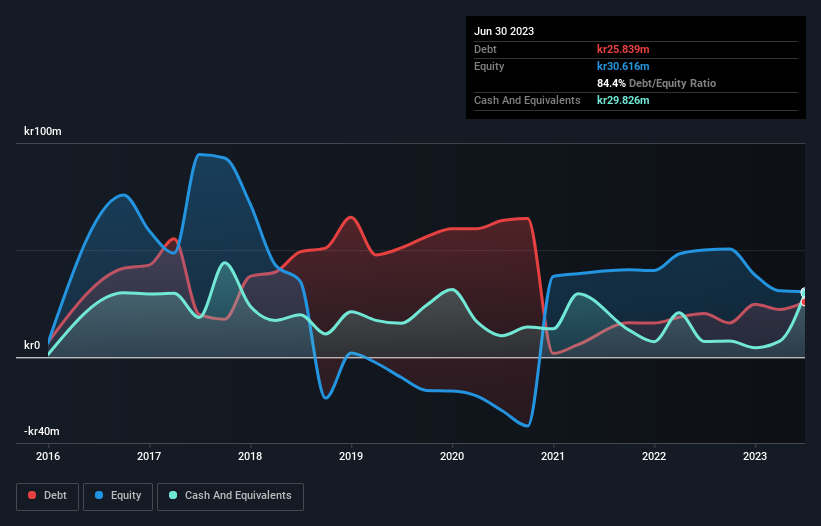- Sweden
- /
- Commercial Services
- /
- OM:SAXG
Saxlund Group (STO:SAXG) Has Debt But No Earnings; Should You Worry?
Legendary fund manager Li Lu (who Charlie Munger backed) once said, 'The biggest investment risk is not the volatility of prices, but whether you will suffer a permanent loss of capital.' So it might be obvious that you need to consider debt, when you think about how risky any given stock is, because too much debt can sink a company. Importantly, Saxlund Group AB (publ) (STO:SAXG) does carry debt. But the more important question is: how much risk is that debt creating?
What Risk Does Debt Bring?
Debt and other liabilities become risky for a business when it cannot easily fulfill those obligations, either with free cash flow or by raising capital at an attractive price. If things get really bad, the lenders can take control of the business. However, a more common (but still painful) scenario is that it has to raise new equity capital at a low price, thus permanently diluting shareholders. Of course, the upside of debt is that it often represents cheap capital, especially when it replaces dilution in a company with the ability to reinvest at high rates of return. When we examine debt levels, we first consider both cash and debt levels, together.
Check out our latest analysis for Saxlund Group
What Is Saxlund Group's Debt?
As you can see below, at the end of June 2023, Saxlund Group had kr25.8m of debt, up from kr20.4m a year ago. Click the image for more detail. But on the other hand it also has kr29.8m in cash, leading to a kr3.99m net cash position.

How Healthy Is Saxlund Group's Balance Sheet?
We can see from the most recent balance sheet that Saxlund Group had liabilities of kr160.8m falling due within a year, and liabilities of kr23.3m due beyond that. Offsetting these obligations, it had cash of kr29.8m as well as receivables valued at kr54.8m due within 12 months. So its liabilities outweigh the sum of its cash and (near-term) receivables by kr99.5m.
Given this deficit is actually higher than the company's market capitalization of kr92.8m, we think shareholders really should watch Saxlund Group's debt levels, like a parent watching their child ride a bike for the first time. In the scenario where the company had to clean up its balance sheet quickly, it seems likely shareholders would suffer extensive dilution. Given that Saxlund Group has more cash than debt, we're pretty confident it can handle its debt, despite the fact that it has a lot of liabilities in total. When analysing debt levels, the balance sheet is the obvious place to start. But you can't view debt in total isolation; since Saxlund Group will need earnings to service that debt. So when considering debt, it's definitely worth looking at the earnings trend. Click here for an interactive snapshot.
In the last year Saxlund Group had a loss before interest and tax, and actually shrunk its revenue by 15%, to kr235m. That's not what we would hope to see.
So How Risky Is Saxlund Group?
While Saxlund Group lost money on an earnings before interest and tax (EBIT) level, it actually generated positive free cash flow kr12m. So although it is loss-making, it doesn't seem to have too much near-term balance sheet risk, keeping in mind the net cash. Given the lack of transparency around future revenue (and cashflow), we're nervous about this one, until it makes its first big sales. To us, it is a high risk play. The balance sheet is clearly the area to focus on when you are analysing debt. But ultimately, every company can contain risks that exist outside of the balance sheet. We've identified 1 warning sign with Saxlund Group , and understanding them should be part of your investment process.
Of course, if you're the type of investor who prefers buying stocks without the burden of debt, then don't hesitate to discover our exclusive list of net cash growth stocks, today.
New: Manage All Your Stock Portfolios in One Place
We've created the ultimate portfolio companion for stock investors, and it's free.
• Connect an unlimited number of Portfolios and see your total in one currency
• Be alerted to new Warning Signs or Risks via email or mobile
• Track the Fair Value of your stocks
Have feedback on this article? Concerned about the content? Get in touch with us directly. Alternatively, email editorial-team (at) simplywallst.com.
This article by Simply Wall St is general in nature. We provide commentary based on historical data and analyst forecasts only using an unbiased methodology and our articles are not intended to be financial advice. It does not constitute a recommendation to buy or sell any stock, and does not take account of your objectives, or your financial situation. We aim to bring you long-term focused analysis driven by fundamental data. Note that our analysis may not factor in the latest price-sensitive company announcements or qualitative material. Simply Wall St has no position in any stocks mentioned.
About OM:SAXG
Saxlund Group
An environmental technology group, develops, manufactures, and services plants and equipment for the production of environmental-friendly and resource-efficient energy.
Adequate balance sheet with slight risk.
Market Insights
Community Narratives



